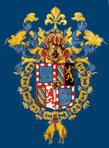The Duchy of Burgundy was one of the major brokers of art, culture, civilization, and power in Western Europe in the fifteenth century. Having amassed huge territorial possessions and fortunes while the kingdoms of England and France were engaged in the Hundred Years War, the Duke of Burgundy attracted many of the finest painters, sculptors, musicians, authors, and poets of the day to his court.
The administration of the duke's wealth was centralized in a single office called the "Chambre des Comptes." Meticulous records of each of the duke's expenses were kept in triplicate and stored in three different locations. These annual records span nearly the entire century and in most cases, at least one of the copies from each year survives today. Included in the itemized and annotated lists of income and expenditures is valuable data establishing the socio-economic profile of this majestic and elaborate court. Of particular interest is the documentation of the duke's extensive patronage of the arts: how much money went to which artists; how often he engaged them; what their specific assignments were. These records remain mostly unedited, however, and are of limited access to scholars and researchers today. The richest repository of surviving accounts is in the departmental archives in Lille, France (ADN).
Over a period of two years, generous support from the Brigham Young University College of Humanities provided for the first phases of this mentoring project, which consists of training students to transcribe and edit some of these documents. In 2005, a team of four graduate students and their faculty advisor participated in an International Studies Program Field Study to Lille. During our two-week stay, we were able to take over 8000 photographs of these archival records. This included the complete expense reports from a period of four years (beginning in 1453). The students involved in the field study also devoted time to transcribing portions of the text from the documents using skills they had acquired in a specialized course where they were trained to read the Middle French dialect and the handwriting of the period.
In 2006, these same four graduate students trained a group of eight undergraduates to assist them in transcribing the complete volume of ducal accounts for the year 1454 (ADN B-2017). The supervising students devised training materials and assisted in establishing an XML-based mark-up language (BART-ML) for the transcriptions. The newly recruited students met regularly with one of the graduate student mentors for training and transcription time. An on-line paleography test determined whether the trainees were sufficiently prepared. As soon as they passed the test, they were invited to participate in the project. In order to ensure the most accurate transcriptions, two different assistants transcribe each page. The second transcription does not include BART-ML tagging.
Project Status
This site constitutes the workspace for the BART project. The diplomatic transcriptions are intended to help train scholars working on similar documents. Abbreviations are not expanded. We use the caret (^) to represent almost all abbreviations. The number 9 is also used to replace 'com' or 'con' when a similar figure appears in the manuscript (e.g., '9ment' = 'comment'). The BART-ML tags allow certain features in the text to be highlighted using the buttons in the "Highlights" menu on the transcription pages. A few of the transcriptions do not include BART-ML tags, hence, highlighting is not activated. Having completed two transcriptions of B-2017 and portions of B-2020, the project is on permanent hiatus.
